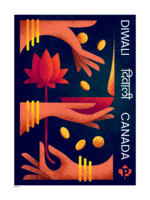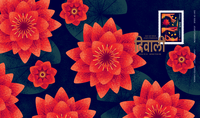
| Name | Value |
|---|---|
| Date of Issue | October 14, 2024 |
| Year | 2024 |
| Quantity | 360,000 |
| Denomination |
 PERMANENT™ (P). PERMANENT™ (P).Current monetary value: $0.92. |
| Postal Administration | Canada |
| Condition | Name | Avg Value |
|---|---|---|
| No Prices for stamp | ||






This stamp heralds the arrival of Diwali, one of the largest, most popular and most widely celebrated festivals in India – and one observed by Hindus, Sikhs, Buddhists, Jains and other communities in Canada and around the world.
The Diwali stamp is one of several annual issues that mark events of importance to Canada’s culturally diverse population. The others include Eid, Hanukkah and Christmas.
The stamp and booklet have two special printing features:
Diwali is a multiple-day (often five-day) celebration that usually falls in October or November. The timing of Diwali day itself coincides with the arrival of the new moon. Also called the Festival of Lights, Diwali’s main theme is the triumph of light over darkness and good over evil.
It should be noted that different regions and communities celebrate aspects of Diwali on different days and in different ways.
During the celebrations, small clay oil lamps called diyas are often lit in rows in homes and temples or set adrift on rivers. There are also often displays of fireworks, symbolizing the triumph of light over darkness.
Families and friends also often exchange gifts and give food and goods to those in need. Colourful geometric Rangoli patterns are often created in entrance ways, living rooms and courtyards, using rice, paint, coloured sand or powder, or flower petals.
Beautiful garlands – known as toranas – are often draped across the entrances and facades of homes and temples. These auspicious decorations (e.g., Rangoli patterns, diyas, toranas) and others that feature prominently during the holiday are intended to welcome guests and – for many – to invite Lakshmi, the goddess of wealth and prosperity, to bestow good fortune on those who enter.
Lakshmi Puja is, for many, the most important occasion during Diwali. People open their doors and windows to welcome Lakshmi, the goddess of wealth and prosperity, who is believed to roam the Earth that night. In anticipation of her arrival, celebrants clean and decorate their homes, make special delicacies as offerings, and prepare their ledger books for her blessing. During Lakshmi Puja, they traditionally light diyas (small clay lamps) to illuminate her way, perform rituals of worship – known as pujas – in her honour, and gather with family and friends to exchange gifts and enjoy feasts and fireworks.